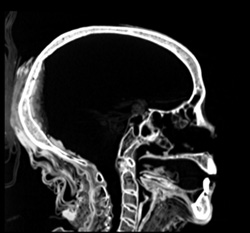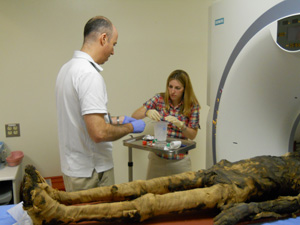Ti Ameny Net Scientific Analysis
The mummy of Ti Ameny Net was originally x-rayed by Professor Stuart Wheeler in 1976 at the Naval Ballistics Laboratory in Indian Head, Maryland. This was made possible by University of Richmond alumnus, Mr. Edward Baroody. CT Images were provided in the 1990s by Dr. James Snyder at the Medical College of Virginia.
J. Lawrence Angel, curator of physical anthropology at the Smithsonian Institution, examined the x-rays at the request of Professor Wheeler and interpreted them as follows:
- Sex Criteria are all clearly female.
- Age Criteria are transitional from young to middle aged, between 30 and 40.
- Stature is between 152 and 155 centimeters -- just under 60 1/2 inches -- a bit shorter than the average for eastern Mediterranean peoples, including Egyptians.
- There are no scars of child birth, and no visible scars of growth arrest at the ends of the long bones.
- There is no indication of pathology.
- There is a slight trace of arthritis.
Professor Wheeler identified several cultural objects wrapped in the linen:
- beside the left thorax at circa T9 level: a snaky handle with two bars.
- on the thorax at T10 level - a flower like daub, possibly a cotton ball.
- at the T10 and L3 levels - two bars circa 2 to 3 centimeters long.
- below and medial to the left knee - a flower like daub.
- at the lateral side of the right ankle, a scroll 47 millimeters long, with a central peg or roller 57 millimeters long, slightly tapering.
New x-rays and CT-scans made at Virginia Commonwealth University Medical Center in 2010 confirm many of Dr. Angel’s findings, but neither the x-rays nor the CT-scans reveal any signs of the cultural artifacts that Wheeler had identified. The new images also show that Ti Ameny Net suffered from scoliosis and severe arthrosclerosis and suggest that she may have been embalmed with her uterus carefully left in place. Also clear are packing materials of resin, wood shavings, or linen, and small sacks of natron left in her peritoneal cavity. While it is likely that Ti Ameny Net bore no children, the lack of pelvic scarring due to childbirth is itself inconclusive. Detailed analysis of the new data (over 25,000 images) is currently being carried out by Dr. Ann Fulcher (’83; Professor and Chair, Department of Radiology, Virginia Commonwealth University Medical Center). Based on this data, a 3D facial reconstruction was created by digital and forensic artist, Joshua Harker.

Sagittal view of Ti Ameny Net’s head, taken with Sensation 64 CT2007s, x-ray computerized tomography at VCU Medical Center in 2010. Photo courtesy Dr. Ann Fulcher, VCU Medical Center

Digital facial reconstruction of Ti Ameny Net by Joshua Harker, based on the 2010 CT images
Click here for a video presentation of the 3D reconstruction
At the time of the new CT-scans, a bone sample was extracted from the pelvis by Dr. Kevin Hoover (Assistant Professor of Radiology, Virginia Commonwealth University Medical Center) for possible DNA analysis. Under the supervision of Dr. April Hill (Clarence E. Denoon Professor of Science, University of Richmond), Caroline Cobert (’12) isolated the DNA and began testing it for possible traces of the cause of death. She determined that Ti Ameny Net did not suffer from tuberculosis or malaria.

Dr. Kevin Hoover and Caroline Cobert collecting a bone sample for DNA analysis, at VCU Medical Center in August 2010
In Spring 2013, the mummy and coffin of Ti Ameny Net were cleaned and conserved by Chris Wilkins (Central Virginia Archaeological Conservation), with the help of two student assistants, Janelle Sadarananda, ’13, and Mimi Hiebert, ’14. While the aim of this conservation project was stabilization of the mummy and coffin, close analysis of materials and conditions yielded important observations about the construction and decoration of the coffin, the process of mummification, and the modern history of Ti Ameny Net. Samples of wood, linen, and other materials were collected for future microscopic and elemental analysis.

Chris Wilkins and Mimi Hiebert

Mimi Hiebert and Janelle Sadarananda



